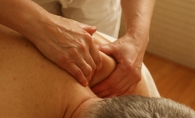Does your neck hurt before you even get out of bed in the morning? Does your low back ache after a day of wearing sky-high heels? Dr. Stefano Sinicropi, board-certified orthopedic surgeon with a subspecialty in spinal surgery, has advice for you and the estimated 80 percent of Americans who will experience spinal pain at some point in their lives. Sinicropi practices at the Midwest Spine and Brain Institute in Edina, as well as other locations throughout the Twin Cities. His professional opinions are based on close to 10 years of clinical experience and more than 4,000 spinal surgeries.
About those high-heeled shoes, for example: wearing higher than 2-inch heels is associated with sprained ankles and painful plantar fasciitis, says Sinicropi, but there is controversy in the research about the effect of high heels on spinal pain. Your best strategy for deciding if high heels make your back hurt is to change shoes. If your back pain goes away over time, those heels may be the source of your back pain.
If your back pain doesn’t go away when you switch to flats, or no matter what you do, be aware that only 15 percent of spinal pain sufferers are candidates for surgery. For the rest, methods like physical therapy and chiropractic, as well as some minimally invasive techniques are often effective. “If your physician isn’t talking to you about a large variety of non-surgical options, you may wish to consult with someone who has experience in these therapies,” say Sinicropi.
Any treatment of spinal pain must also include consideration of a patient’s habits: how (and how much) a person sleeps, what medications they use and if they smoke. “Smoking, all by itself, is associated with a greater incidence of back pain,” says Sinicropi. One of the first strategies he uses for a smoker with back pain is smoking-cessation intervention. Also critical to many patients’ spinal pain relief, Sinicropi says, is a discussion of nutrition and weight. “I often prescribe a paleo diet,” says Sinicropi. The relationship of a patient’s pain to depression or other psychological issues should always be investigated. People may be depressed if they have chronic pain, of course, says Sinicropi, but depression can also be one of several causes of pain.
What can the average person do to minimize back and neck pain? “Find an appropriate mattress,” Sinicropi says. “Some of the hard/soft mattress quandary has been eliminated by products such as the Sleep Number bed. And side-sleeping with a pillow between your legs is often a good option.” People should also make an effort to get enough sleep. One of the most overlooked causes of chronic pain, says Sinicropi, is too little sleep.
Also, working while sitting and slouching forward can put extra pressure on spinal discs. Try a standing workstation. Sacroiliac joint pain may also be relieved with less sitting. Finally, while he is a big proponent of weight lifting and high-intensity workouts, Sinicropi advises getting professional advice from a physical therapist or a trainer before beginning such a program.
If it looks like spinal surgery will be necessary to relieve your pain, seek a surgeon who offers and has a record of performing a wide variety of surgical interventions. Ask about your surgeon’s experience with different procedures, and seek to fully understand what the post-surgical course will be. Finally, says Sinicropi, come in with a written list of questions and make sure they’re answered. “There is great value,” he says, “in a well-informed patient.”
Learn more at the website here.









